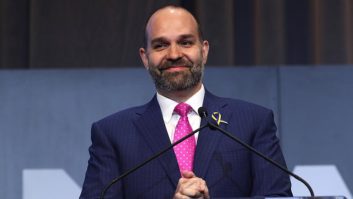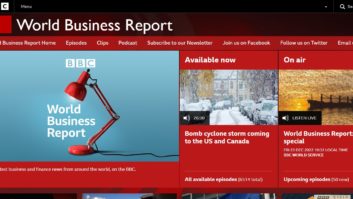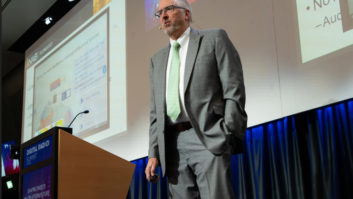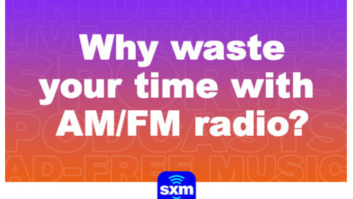
From left: Tom Bender, Alan Segal,Dan Shelley and Pat Walsh “In the digital world, we’re not competing against just radio,” said Alan Segal, senior director, Digital Insights, a part of Cox Media Group in Atlanta. “This is a radio show, but we are really competing against everything digital.”
That statement reflects the insight of one of the panelists who will participate in a Radio Show session with the unusual title, “What Do We Need to Stop Doing (Digitally)?”
It will be presented Wednesday, September 10 at 2:30 p.m.
“This is important from an audience perspective if not strictly from a revenue standpoint,” Segal said. “You are in a dogfight with everyone out there who can grab the listeners’ attention.
“Is someone not listening to your stream because he is listening to Spotify? A radio competitor? Is he playing ‘Angry Birds?’ That’s the fight you should be in on a daily basis. It’s not just about the station down the street; it’s about the endless list of choices out there.”
Tom Bender, senior vice president/general manager, Greater Media Interactive, Detroit, sees a common pitfall in radio’s digital endeavors.
“By the very nature of digital and the constant waterfall of new products, ideas and refinements, we all can easily fall into the ‘bright shiny object’ syndrome,” he said.
“If it’s new and has a buzz, we’ve got to have it. I know from experience that numerous digital initiatives look promising, and those promoting them promise a great return, but too often, nine months into the project, reality starts to set in. There are execution issues that weren’t thought through and advertisers want a lower price.”
This Internet Thing Will Never Catch On Every emerging trend has been pooh-poohed by someone. According to rinkworks.com, a Western Union executive said in 1876 said that “the telephone has too many shortcomings to be seriously considered as a means of communication.” Many years later Decca Records took a pass on a singing act called The Beatles, predicting that “they have no future in show business,” according to minyanville.com. In 1966, this writer told his girlfriend Allison that Madras shorts and Paisley ties were here to stay.
But talk about the mother of all horrible predictions. On Feb. 26, 1995, Newsweek writer Clifford Stoll misread the tea leaves in his article “Why the Web Won’t Be Nirvana.”
He said in part: “Visionaries see a future of telecommuting workers, interactive libraries and multimedia classrooms. They speak of electronic town meetings and virtual communities. Commerce and business will shift from offices and malls to networks and modems. Baloney. Do our computer pundits lack all common sense? The truth in no online database will replace your daily newspaper, no CD-ROM can take the place of a competent teacher and no computer network will change the way government works.”
You can read the article athttp://tinyurl.com/rwstoll.
So how about this Internet thing? Do you think it’ll ever catch on? But Bender also has a way to avoid this potential misstep.
“Before we bring new technology or digital inventory online, we should take the time to make the business case. Does it fit within our sales strategy; is there a need or opportunity in our local markets; and is there internal bandwidth and commitment to present and implement it?”
Dan Shelley is senior vice president of local and studios for Interactive One, part of Radio One. He believes that radio undervalues its digital product.
“Too many radio groups are still ‘giving away’ digital ads, or at least telling their clients digital is free and then shifting the dollars internally to pay for it. That makes it harder for the rest of us who stopped giving away digital years ago.”
And Shelley believes that broadcasters have not yet fully embraced mobile technology.
“I don’t mean just streaming,” he said. “At Radio One, as much as 80 percent of the people who engage with our stations digitally each month do so on smartphones or tablets. Our primary audience indexes higher in mobile than other demographic categories, but the seismic shift from desktop to handheld devices is happening with everyone. You’ve got to make a huge mobile play — from both the content and ad perspectives — or you won’t be reaching a significant portion of your audience, or your clients’ customers,” he said.
“Too many stations still do contests for ‘the tenth caller.’ Really? In 2014? Listeners don’t call radio stations to try to win contests — at least not millennials and Gen-Xers. They text. Stations must engage with their audiences where their audiences are, not where they used to be.”
ENGAGED STAFF
Pat Walsh, COO of Emmis Communications in Indianapolis, will moderate this session. His background includes a stint with iBiquity Digital, developer of HD Radio technology.
To minimize missteps in radio’s digital realm, he recommends that broadcasters seek out non-traditional radio people.
“We have hired many people with a digital content and social media background,” he said “These are young people, millennials, who have grown up in the digital world and have a different perspective on content. We have recruited a lot of folks that have worked in startups, either technology or digital media, because we want to engage our audiences on their phones, their tablets and desktops.
“Part of the magic has been combining the deep knowledge of radio that our programming and on-air talent have, with the knowledge these young people we have brought into the industry.”
Where is the common ground among these groups?
“It’s all in the passion for the music, or the spoken word, or whatever the content of the station is,” he said. “People on our digital and social media development teams very often are fans of the content; and it’s a natural extension for them to reach our audiences on digital platforms.”
Walsh says that just because a person has a knack for audio programming, it does not necessarily follow that this person is well-versed in the nuances of Twitter, Facebook or YouTube. “Stations that avoid hiring new talent from the digital realm do so at their own peril.”
Segal agreed, but went further, citing a need to use digital-savvy outside talent for specific tasks at a radio station.
“We might build the best digital widget in-house; but why would we? It’s not our core expertise,” he said. “Ours is telling stories. Why not partner with someone who can develop something for us, fix it, and let us do what we do best, playing music or whatever that happens to be. We need to stop thinking we can solve everything ourselves.”
Segal talked about qualities he seeks when planning digital projects.
“I look for humility,” he said. “I want people who recognize they don’t know everything, because if they think they know everything, they won’t want to be open and listen. I want people with an appetite to learn. A lot of people can sit at a computer and do things, but a great digital person has to create relationships to make sure everyone is exposed to the larger scene. They touch base with people across many departments to make sure things fit together.”
Ken Deutsch is a former broadcaster and longtime Radio World contributor.












